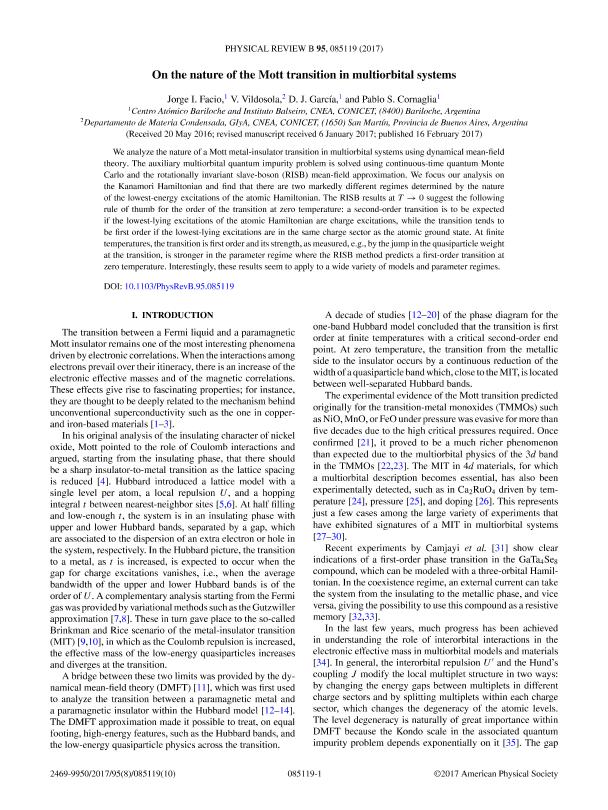Mostrar el registro sencillo del ítem
dc.contributor.author
Facio, Jorge Ismael

dc.contributor.author
Vildosola, Veronica Laura

dc.contributor.author
Garcia, Daniel Julio

dc.contributor.author
Cornaglia de la Cruz, Pablo Sebastian

dc.date.available
2020-11-04T13:44:58Z
dc.date.issued
2017-02
dc.identifier.citation
Facio, Jorge Ismael; Vildosola, Veronica Laura; Garcia, Daniel Julio; Cornaglia de la Cruz, Pablo Sebastian; On the nature of the Mott transition in multiorbital systems; American Physical Society; Physical Review B: Condensed Matter and Materials Physics; 95; 8; 2-2017; 1-10
dc.identifier.issn
2469-9969
dc.identifier.uri
http://hdl.handle.net/11336/117593
dc.description.abstract
We analyze the nature of a Mott metal-insulator transition in multiorbital systems using dynamical mean-field theory. The auxiliary multiorbital quantum impurity problem is solved using continuous-time quantum Monte Carlo and the rotationally invariant slave-boson (RISB) mean-field approximation. We focus our analysis on the Kanamori Hamiltonian and find that there are two markedly different regimes determined by the nature of the lowest-energy excitations of the atomic Hamiltonian. The RISB results at T → 0 suggest the following rule of thumb for the order of the transition at zero temperature: a second-order transition is to be expected if the lowest-lying excitations of the atomic Hamiltonian are charge excitations, while the transition tends to be first order if the lowest-lying excitations are in the same charge sector as the atomic ground state. At finite temperatures, the transition is first order and its strength, as measured, e.g., by the jump in the quasiparticle weight at the transition, is stronger in the parameter regime where the RISB method predicts a first-order transition at zero temperature. Interestingly, these results seem to apply to a wide variety of models and parameter regimes.
dc.format
application/pdf
dc.language.iso
eng
dc.publisher
American Physical Society

dc.rights
info:eu-repo/semantics/openAccess
dc.rights.uri
https://creativecommons.org/licenses/by-nc-sa/2.5/ar/
dc.subject
MOTT TRANSITION
dc.subject
HUND
dc.subject
DMFT
dc.subject
RISB
dc.subject.classification
Física de los Materiales Condensados

dc.subject.classification
Ciencias Físicas

dc.subject.classification
CIENCIAS NATURALES Y EXACTAS

dc.title
On the nature of the Mott transition in multiorbital systems
dc.type
info:eu-repo/semantics/article
dc.type
info:ar-repo/semantics/artículo
dc.type
info:eu-repo/semantics/publishedVersion
dc.date.updated
2020-11-02T17:02:58Z
dc.identifier.eissn
1098-0121
dc.journal.volume
95
dc.journal.number
8
dc.journal.pagination
1-10
dc.journal.pais
Estados Unidos

dc.journal.ciudad
New York
dc.description.fil
Fil: Facio, Jorge Ismael. Comisión Nacional de Energía Atómica. Gerencia del Área de Energía Nuclear. Instituto Balseiro; Argentina. Consejo Nacional de Investigaciones Científicas y Técnicas; Argentina
dc.description.fil
Fil: Vildosola, Veronica Laura. Consejo Nacional de Investigaciones Científicas y Técnicas; Argentina. Comisión Nacional de Energía Atómica. Gerencia de Área Investigaciones y Aplicaciones No Nucleares. Gerencia Física (CAC). Departamento de Física de la Materia Condensada; Argentina
dc.description.fil
Fil: Garcia, Daniel Julio. Consejo Nacional de Investigaciones Científicas y Técnicas; Argentina. Comisión Nacional de Energía Atómica. Gerencia del Área de Energía Nuclear. Instituto Balseiro; Argentina
dc.description.fil
Fil: Cornaglia de la Cruz, Pablo Sebastian. Consejo Nacional de Investigaciones Científicas y Técnicas; Argentina. Comisión Nacional de Energía Atómica. Gerencia del Área de Energía Nuclear. Instituto Balseiro; Argentina
dc.journal.title
Physical Review B: Condensed Matter and Materials Physics

dc.relation.alternativeid
info:eu-repo/semantics/altIdentifier/url/https://journals.aps.org/prb/abstract/10.1103/PhysRevB.95.085119
dc.relation.alternativeid
info:eu-repo/semantics/altIdentifier/doi/http://dx.doi.org/10.1103/PhysRevB.95.085119
Archivos asociados
